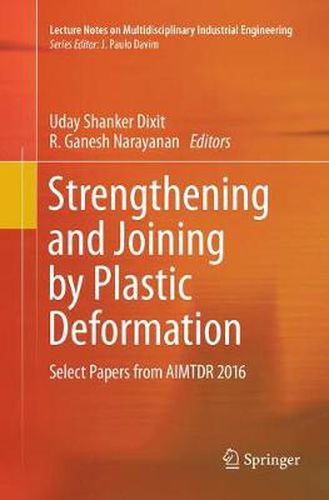Readings Newsletter
Become a Readings Member to make your shopping experience even easier.
Sign in or sign up for free!
You’re not far away from qualifying for FREE standard shipping within Australia
You’ve qualified for FREE standard shipping within Australia
The cart is loading…






This book focuses on strengthening and joining materials by means of plastic deformation, gathering extended research papers presented at the AIMTDR 2016 conference. Plastic deformation is used in materials processing to improve the strength of the material. For example, the rod/screw used to connect the cooker handle to the main body has to be strong and sustainable; such rods can be strengthened by plastic deformation (using multi-stage forming operations etc.). Similarly, joining by means of plastic deformation is highly valuable since it avoids the material and environmental degradation often caused by fusion welding processes. The book discusses various processing techniques in which plastic deformation is used to strengthen materials - e.g. in equal channel angular extrusion, autofrettage etc., or to join materials without melting them - e.g. in friction stir processing, riveting etc. Offering an extensive guide, the book includes chapters on roll bonding, equal channel angular pressing, autofrettage, friction stir processing/welding, magnetic pulse welding, and riveting - processes used to strengthen and join a variety of materials for lightweight applications and sustainable manufacturing. The contents of this book will be useful to researchers and practitioners alike.
$9.00 standard shipping within Australia
FREE standard shipping within Australia for orders over $100.00
Express & International shipping calculated at checkout
This book focuses on strengthening and joining materials by means of plastic deformation, gathering extended research papers presented at the AIMTDR 2016 conference. Plastic deformation is used in materials processing to improve the strength of the material. For example, the rod/screw used to connect the cooker handle to the main body has to be strong and sustainable; such rods can be strengthened by plastic deformation (using multi-stage forming operations etc.). Similarly, joining by means of plastic deformation is highly valuable since it avoids the material and environmental degradation often caused by fusion welding processes. The book discusses various processing techniques in which plastic deformation is used to strengthen materials - e.g. in equal channel angular extrusion, autofrettage etc., or to join materials without melting them - e.g. in friction stir processing, riveting etc. Offering an extensive guide, the book includes chapters on roll bonding, equal channel angular pressing, autofrettage, friction stir processing/welding, magnetic pulse welding, and riveting - processes used to strengthen and join a variety of materials for lightweight applications and sustainable manufacturing. The contents of this book will be useful to researchers and practitioners alike.